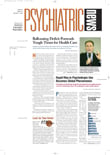In addition to searching for better treatments for social anxiety disorder (
see article above), psychiatric researchers are coming up with some interesting new insights into the disorder. These are a few of them.
Social anxiety disorder used to be considered quite rare. No more. Epidemiological studies conducted in Canada, France, Germany, and the United States have revealed that it is one of the most common mental health problems. In fact, it appears to be the third most common psychiatric disorder in the United States after depression and alcohol abuse, Mark Pollack, M.D., an associate professor of psychiatry at Harvard University and director of the anxiety treatment program at Massachusetts General Hospital, told Psychiatric News.
Why do so many people experience social anxiety disorder? According to Randolph Nesse, M.D., it may be that it is not a pure disorder, but rather an extreme of an emotion that most people experience. Nesse is a professor of psychiatry at the University of Michigan, former director of the university's anxiety clinic, and an authority on evolutionary biology in medicine.
Various avenues of evidence support this hypothesis, he explained in a recent interview. For example, social anxiety occurs in every part of the world, not just in modern cultures; it also occurs in primates other than humans; and there is no bimodality in its distribution among people. In other words, scores on a social phobia scale show that that there is a very continuous, normal distribution of social phobia—it's not just a case of most people having a little social phobia and some people having a lot.
So, if virtually everyone experiences social anxiety—and not just people with social anxiety disorder—what is the reason? Said Nesse,“ Social anxiety is shaped, I think, to help us deal with all kinds of social situations where other people might be critical of us, not just with situations involving competition.”
Nesse also believes that his hypotheses can benefit people with a social anxiety disorder. “They suffer terribly... but it is important to help them recognize that social phobia has benefits as well as costs. This realization will help them not just look for a cure, but for coping strategies.”
What happens in the brain to produce social anxiety disorder? Not a lot is known at this point, but at least a few things, thanks to brain-imaging studies. Social anxiety disorder involves overactivity of neurons in the amygdala and underactivity of neurons in higher cortical centers such as the prefrontal cortex.
When a person with the disorder is thinking about something anxiety provoking—say, going to a party—his amygdala probably sends out fear signals, and at the same time his prefrontal cortex thinks, “I shouldn't be nervous; they are just ordinary people. What's the big deal?” But because the amygdala is overactive and the prefrontal cortex underactive, the amygdala wins.
Or as Jack Gorman, M.D., chair of psychiatry at Mount Sinai School of Medicine, explained in an interview: “For some reason, people with social anxiety get more `amygdala' and less `prefrontal,' so that they are unable to gate those fear messages from the amygdala.”
